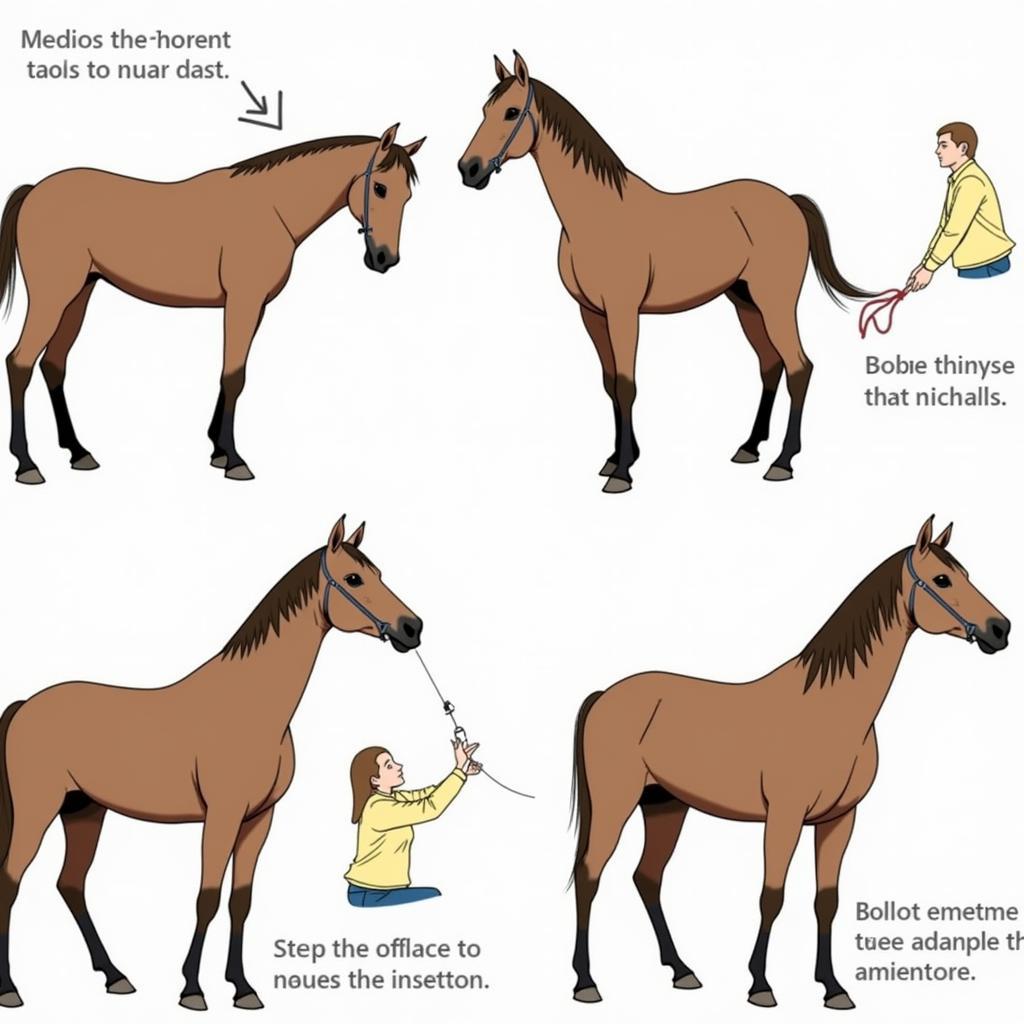Administering an enema to a horse can be a necessary procedure for various health reasons. This guide provides a comprehensive overview of why, when, and how to perform this sometimes delicate procedure, equipping you with the knowledge to care for your equine companion effectively.
Understanding the Need for an Enema for Horses
An Enema For Horses is the introduction of fluid into the rectum and colon to stimulate bowel movements. This procedure is typically employed to relieve constipation, evacuate the bowels before surgery or diagnostic procedures, or administer medications. Understanding the underlying cause for constipation is crucial before administering an enema, as it can range from simple dietary issues to more serious conditions requiring veterinary intervention.
Common Reasons for Administering Equine Enemas
- Constipation: This is the most common reason for administering an enema. Signs of constipation in horses include infrequent or absent bowel movements, straining to defecate, and reduced appetite.
- Pre-surgical Preparation: Emptying the bowels before surgery reduces the risk of complications and ensures a clearer surgical field.
- Diagnostic Procedures: A clean colon is essential for accurate imaging and other diagnostic procedures.
- Medication Administration: While less common, certain medications can be administered rectally via an enema.
 Enema Administration in Horses
Enema Administration in Horses
Preparing for an Equine Enema
Proper preparation is essential for a successful and stress-free enema administration. Gathering the necessary equipment and ensuring a calm environment are crucial for both your horse’s comfort and your safety.
Essential Equipment
- Enema Bag: Choose a bag specifically designed for horses, ensuring it is clean and in good working order.
- Lubricant: A water-based lubricant is crucial for easy insertion of the enema tube and minimizing discomfort for your horse.
- Warm Water: Lukewarm water is the most common enema solution. Avoid using hot or cold water, as this can cause discomfort or shock.
- Tubing: Ensure the tubing is appropriate for equine use, flexible, and clean.
- Gloves: Protect yourself from potential pathogens by wearing disposable gloves.
- Bucket: Have a bucket readily available for collecting the expelled fecal matter.
 Essential Equipment for an Equine Enema
Essential Equipment for an Equine Enema
Administering the Enema
The process of administering the enema requires patience and a gentle approach. Rushing the procedure can cause stress and discomfort to your horse.
Step-by-Step Guide
- Prepare the Solution: Fill the enema bag with lukewarm water.
- Lubricate the Tubing: Apply a generous amount of water-based lubricant to the end of the tubing.
- Insert the Tubing: Gently insert the tubing into the horse’s rectum, aiming slightly upwards.
- Administer the Fluid: Slowly elevate the enema bag, allowing the fluid to flow into the rectum.
- Remove the Tubing: Once the bag is empty, gently remove the tubing.
- Observe Your Horse: Monitor your horse for signs of bowel movement.
When to Call the Vet
While administering an enema can be a routine procedure, certain situations warrant immediate veterinary attention. If your horse experiences excessive straining, signs of pain, or does not produce a bowel movement after the enema, contact your veterinarian promptly.
Conclusion
Administering an enema for horses can be a beneficial procedure when performed correctly. Understanding the process, preparing adequately, and approaching the task with patience ensures the best outcome for your equine companion. However, remember that this guide serves as a general overview, and consulting with your veterinarian for specific advice related to your horse’s individual needs is crucial.
FAQs
- How often can I give my horse an enema?
- What are the signs of a successful enema?
- Can I use soap instead of water for the enema solution?
- What should I do if my horse resists the enema?
- Are there any alternatives to enemas for treating constipation in horses?
- How do I know if my horse is constipated?
- Can I administer an enema without veterinary guidance?
Common Scenarios and Questions
-
Scenario: Horse hasn’t passed manure in 24 hours.
-
Question: Should I administer an enema immediately?
-
Scenario: Horse is showing signs of colic.
-
Question: Is an enema appropriate in this situation?
-
Scenario: The enema fluid isn’t flowing into the rectum.
-
Question: What could be the problem?
Further Reading and Resources
For more information on equine health and wellness, visit our other helpful articles on Justus Horses USA. You can also find valuable resources on horse care and management from reputable organizations such as the American Association of Equine Practitioners.
Need Help? Contact Us!
For any assistance or questions regarding equine health and care, feel free to reach us at Phone Number: 0772127271, Email: [email protected] Or visit our location: QGM2+WX2, Vị Trung, Vị Thuỷ, Hậu Giang, Việt Nam. We have a 24/7 customer support team.